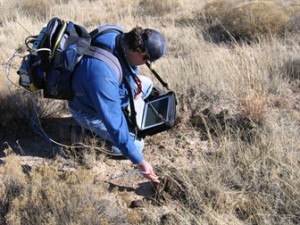GANLAB Program provides science-based results
March 2011

Stephen Prince, a researcher at Blackland Research and Extension Center, examines the light reflectance signatures from a scan of manure.–Photo by Center for Natural Resource Information Technology, Blackland Research and Extension Center
By CLAY COPPEDGE, Country World staff writer
May 26, 2011 – Hunters, trackers and outdoors people from all over have long known the value of droppings (manure) to determine what an animal has been eating. Technology has taken that notion a step further with a software program known as the Grazing Animal Nutrition Lab, or GAN Lab, for short.
The Grazing Animal Nutrition Lab (GAN Lab) at the Blackland Research Center in Temple uses a technology called near infrared reflectance spectroscopy (NIRS) to analyze fecal samples and make recommendations based on results that shows dietary crude protein, digestible organic matter and other nutritinal factors in a cow’s diet..
Stephen Prince, director of the lab, said the technology uses NIRS to create a nutritional profile of free range livestock.
“We help determine the quality of a pasture by using manure samples and analyzing them,” he said. “Feed costs and grazing costs are two big factors in any livestock operation. Controlling those costs is important to making money with livestock. This is another tool to help with those decisions.”
The GAN Lab began in 1988 strictly as a research based operation to study animal nutrition and monitor grazing behavior. Dr. Jerry Stuth, GAN Lab founder, added a nutritional balance profile (NUTBAL Pro) software program and the NIRS system of fecal analysis was offered to the public in 1994. The GAN Lab has profiled the nutrition of cattle, goats, sheep, bison and wildlife like elk and deer for a variety of users.
“The NRCS (Natural Resources Conservation Service) is the biggest customer for this,” Prince said. “They use it as part of the cost- share for some of their programs. Farmers, ranchers, researchers and government agencies here and abroad all use it.”
Users of the program are asked for information regarding animal attributes, environmental conditions, pasture conditions and feeding programs. The NUTBAL Pro software then determines if the animals are getting enough nutrition as well as their daily weight gain or loss and the most effective feeding option if supplementation is needed.
The program produces two reports. One describes nutritional intake requirements and balance. The second report, the Mediation Report, offers the most efficient feed alternatives, including the cost of that alternative per day. It is available on CD-Rom, which also includes electronic copies of training materials and sampling instructions.
“The fecal sample you send us should have been in the pasture at least 48 hours before the sample is taken,” Prince said. He added that the sample should be as “pristine” as possible, meaning that the sample needs to be free of dirt, grass and insects. For ranchers who are rotating cattle from one pasture to another, producers should choose a sample with the highest correlation to what the animal was eating 36 hours previously. The producer should take five to 10 fresh fecal pies or a composite sample.
The user is expected to provide two zip-lock or freezer bags, plastic gloves, a disposable spoon, ink marker, mailing labels and tape or masking tape. The lab will provide a cardboard mailing box, Styrofoam cooler, gel pack and a sample form. The pack is frozen overnight and the Styrofoam lid is labeled with the customer’s address and the address of the GAN Lab. Results will be emailed or faxed to the customer about four days later.
“This can tell you when you need to pull a cow off a pasture or when you need to supplement and what kind of supplement is recommended,” Price said. “It helps take the guesswork out of the nutritional management of your herd.”
Price said that lab technicians want to know the health of the whole herd and so recommends getting samples that represent one herd and one pasture. While the lab focuses on nutritional factors such as protein and energy, research is now under way to address livestock issues such as minerals, parasites and soil analysis.
For more information, go to the GAN Lab website at cnrit.tamu.edu or call (254) 774-6134.
–Reprinted with permission of Country World Central Texas
